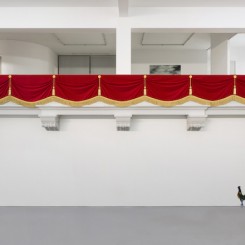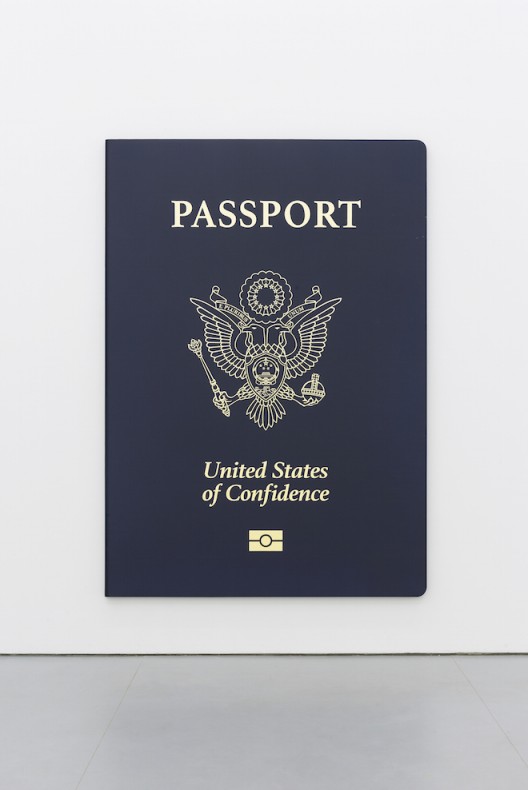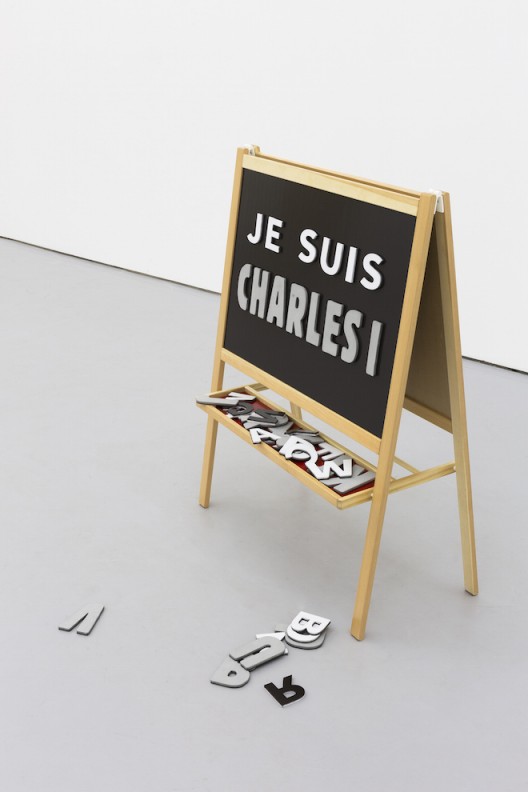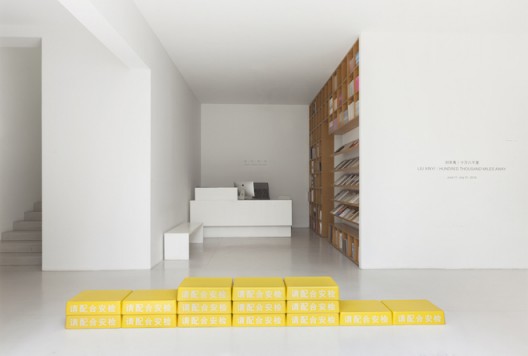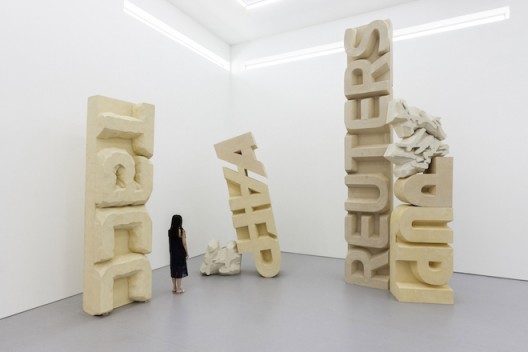White Space (No.255, Caochangdi Airport Service Road, Chaoyang District, Beijing 100015), Jun 11–Jul 31, 2016
People enjoy discussing feelings, intuitions, and experiences with regard to works of art; the production of knowledge, in contrast, might not be terribly pertinent to many artists’ work. Liu Xinyi begs to differ. In his view, art is not completely about the expression of personal insights, but rather about looking into topics that elicit interest and re-generating ideas about knowledge.(1) With his habit of “acquiring knowledge by investigating things” (a maxim from ancient Confucian text Great Learning), Liu hopes to grasp the logic beneath a myriad of phenomena, from daily interactions with all manner of characters to the greater narratives of state and international affairs.
The placement of every detail in Liu Xinyi’s work is therefore founded on evidence-based research. For his series Block Trading Empire, Liu specifically mentions how as part of the creative process, he conducted extensive research comparing the geographical contours of regions with the silhouettes of animals in order to decide how to pair them. This work juxtaposes two common visual imageries in life: charts of cuts of meat in supermarkets and the geopolitical boundaries on world maps. For the artist, the world is a huge supermarket. On earth, people define borders on land and on the sea; in the supermarket, different cuts of meat are priced from low to high. In both cases, the designations are projections of authority aimed at the optimal redistribution of resources and profits.
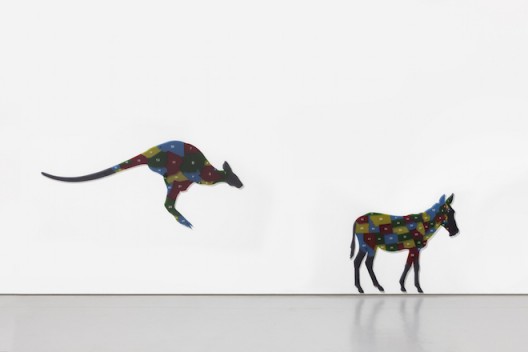
Liu Xinyi, “Block Trading Empire–African Kangaroo”, acrylic boards, acrylic standoffs, 118 × 240 × 4 cm, 2016, and Block Trading Empire–North American Wild Donkey”, acrylic boards, acrylic standoffs, 120.5 × 133 × 4 cm, 2016
This set of works clearly displays Liu Xinyi’s strategy in the production of knowledge: as he “glides” from one image to another, he connects things from different categories; the semantics shifts, thus allowing the public to generate new understandings.(2) With his practice in recent years, Liu has perfected this strategy. In many artworks, the semantics has been shifted so that it is borne by visualization. For instance, in “Working Out Class”, the artist has grafted a hammer, the working class symbol, onto a dumbbell, the middle class symbol, thus adroitly pointing to wholesale changes in lifestyle following changes of ideology in formerly Socialist countries. In the meantime, the artist anchors the works with their titles, shifting the chain of meaning. In other works, such as “Safety First”, the audience is invited to participate so that their bodies are incorporated into the chain of signifiers.
For an artist, it is a sign of maturity if their work reaches a sense of logical consistency; this suggests that their career has experienced certain fluctuations and turbulence after taking off, and is now cruising smoothly. Yet in this exhibition, the semantic games that Liu is accustomed to have begun to reveal certain limits. Aside from pointing out the source of the works’ experiential material, the title of the exhibition “Hundred Thousand Miles Away” also sums up Liu Xinyi’s methodology thus far: creating semantic shifts with visual imagery as signs within the work. In the mean time, it points to the distance between reality and preconceived ideas.
The piece “Wonderland” embodies the aforementioned elements, originating in the artist’s reflections about border posts. On the one hand, for example, as enforced through airports, border posts are undoubtedly strict and uncompromising, and yet their actual positions are within the cartographical boundaries of a country or region. On the other hand, the real borders are often located in uncertain places such as rivers or the open sea. The artist juxtaposes border checkpoints with itinerant street vendors, finally linking them to brightly colored “wonderland” imagery. Vendors signify flow or circulation, whereas “wonderland” might suggest a fictitious, artificial environment. Through the chain of symbols constructed by visual imagery and exhibition titles, the seemingly secure position of border posts and the authority they represent are questioned. A similar structure can be found in a few other works in the exhibition which point to the unknown (“Nine Segments Sausage”) and the mutability (“The Road of Arab Ba’ath Movement”) in all sorts of political, geographical, and cultural boundaries.
Liu’s semantic game over the concept of “borders” in the end forces the works into retreat and hems them inside the classic triangle of “concept”, “language”, and “reality” in classic Conceptual art and inside endless metaphysical reflections. For decades, artists have been tirelessly reiterating the gaps between language, meaning, and reality. Though there are better and worse approaches, the philosophical question is utterly without novelty today; what can be substituted are the concrete examples and visual forms used to expound on this issue. Just as in life, however, humor tears a crack in ordinary experience, momentarily subverting the rules. But jest remains jest precisely because no one takes it very seriously. In the end, if the exhibition itself offers an opportunity to break down established ideas or interpretations as the criteria to judge the efficacy of a work, then in that case, how can pointing out that various specific or abstract boundaries are neither natural nor eternal be considered a new understanding, in any sense of the term?
Supposing that some definite knowledge is still a worthwhile pursuit, certain other works in the exhibition offer possible pathways. Through rigorous restorations of detail, “Royal Balcony” transposes the grand balcony of England’s Buckingham Palace to a gallery space, shifting the power structure of surveillance and the surveilled between royalty and commoners to that between gallery managers on the one hand and artists and visitors on the other. And “Confident Citizenship”, at first glance, looks seamlessly constructed, but it is in fact an imaginary, nonexistent passport for world citizenship.
In these works, symbols are not transposed deliberately; instead, their basic structure is maintained while the visual signifiers are deconstructed and regrouped, thus testing or even provoking the visitor’s direct response to the symbols. Viewers are thus asked to consider, as individuals immersed in specific historical contexts and with specific visual experiences, what controls our intuition? Who is in control? How is this controlled? Rather than being endlessly suspended in a labyrinth of signs over hundreds of thousands of miles, this series of works is not merely focused on the “conceptual”; it asks direct questions of specific experiences—an important step in propelling the work towards definite knowledge.
(1) From the interview, in Chinese, “Liu Xinyi Tan Zishen Chuangzuo (刘辛夷谈自身创作)” (“Liu Xinyi Talks about His Own Works”) on Artforum.com.cn, Jan 15, 2014.
(2) The artist admits the influence on his work of Roland Barthes’ Empire of Signs; on his own website, Liu writes, “Barthes’ analysis of Japanese cultural signifiers left a rhetorical impression on me in how it jumps from one point to another.”
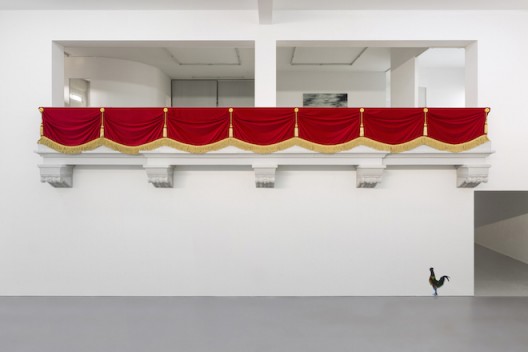
Liu Xinyi, “Royal Balcony”, polystyrene, velvet, ropes, tassels, flower-shaped clasps, 200 × 1100 × 70 cm, 2016
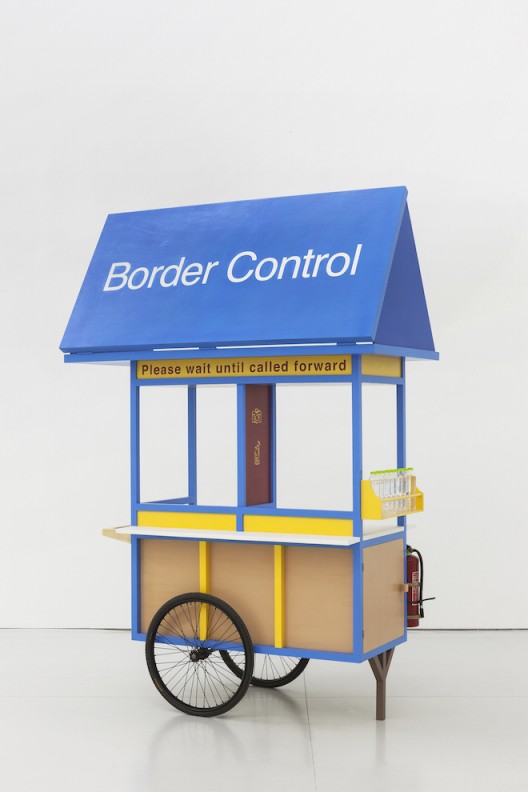
Liu Xinyi, “Wonderland”, timber, multilayer boards, tricycle wheels, axle, bottled waters, fire extinguisher, waterborne paint, stools, overall dimensions variable, 2016
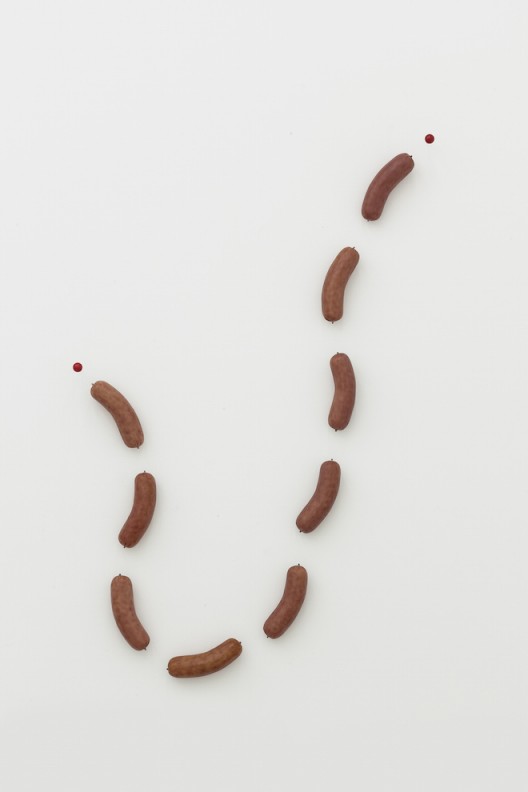
Liu Xinyi, “Nine Segments of Sausage”, polyurethane, phenolic resin, aluminium bars, oil paint, overall dimenisons, 290 × 172.5 × 16 cm, 2016
